I’ve been noodling around the internet b/c of this thread and saw a race breeder with a pair of really well-balanced, big-boned arabs that they claimed were 16h. Really nice conformation, solid hind end. Attractive, but not super typey in the face. I believe there was french influence?
I’m certainly no expert, but thank you for the compliment! I grew up immersed in the arabian show world, but left that behind many, many years ago. I wouldn’t be paying attention at all if I didn’t happen to own a half-arab.
But in working for a breeder who did a lot of arab x WB crosses, plus just being around so darn many arabs in my youth and having a lot of acquaintances still in the industry, I think the most important thing is a mare who reproduces her best traits.
As I said earlier, my own mare’s dam was Polish/Russian. She wasn’t a good broodmare, but I don’t think that’s a reflection on the lines. @whichchick hit the nail on the head when she said the racing bred ones tend to be more flat-kneed.
The best arab x WB crosses I’ve known were out of a mare who I wouldn’t have expected, Egyptian with maybe 40 or 50% Crabbet blood.
I grew up with a lot of Egyptian and Crabbet horses around. Some I think would have been good candidates. Others, not so much. Arabs tend to be so inbred that it’s rare to see a pedigree with names I don’t recognize far enough back, yet I do not have the knowledge to make heads or tails of it in most cases. Also, for some reason, the arab breed seems to attract an increased number of hoarder breeders who breed for quantity, not quality. There are quite a number of “highly regarded” breeders who I would not recommend because I am morally opposed to how they go about “developing” lines.
So everything I know about French arabs come from COTH, so take it with a grain a salt. But a while back, there was a thread on some drool-worthy French stallions and it was echoed several times that French arabs are infamous for not being purebred despite being advertised as such. I don’t know if that’s true, but if one wanted to go that route, I might double check AHA registration status first.
I saw the stallion *Zahid at an Arabian horseshow in Michigan MANY moons ago. I believe he was straight Egyptian and was easily 16 hands. He was entered in a Park class before they wanted the “extreme” moving front ends. (He would have been considered an English Pleasure horse by way of movement later; there WERE some of those types in his class that day.)
What I remember after him winning the Park class was the show vet going up to the rider. I didn’t hear exactly what she said to the rider, but the rider asked her, “Would you like to ride him?” And she did, and *Zahid was SO well-behaved with her.
East-coast I like FCF Oberon’s Vanity. He’s 15 hh in “real horse” height and he does not THROW height – bred to other Arabs, he looks to throw about 14.2, 14.3hh. Pick a tall mare. They do cooled-shipped if you’re into that. He’s got a decent resume and has some chops. https://www.faeriecourtfarm.com/fcf-oberons-vanity.html (Also on facebook, under faeriecourtfarm, he just did Vermont Dressage Days with PSG tests.) I also really, really like the crabbet stallion SSA Dargon PC (video here: https://vimeo.com/213136785 ), who does not have near the resume that Oberon does. He’s 15hh in real horse size (I’ve seen him up close and in person and he’s taller than my legit-sticked 14.3hh arab with really nice solid feet and legs. He throws a floaty trot, damn decent back legs, and a lively personality.
Both of these stallions are heterozygous grey, so you’re 50-50 on the “How hard will this horse be to keep clean” question, if that’s an issue for you.
Full disclosure: I do not own an interest in either stallion. I am not getting paid to promote anyone’s stallion.
OK. The vast majority of my WB pedigree studies was with the Holstein mares.
You go back far enough there is a SIGNIFICANT amount of Arab blood, pure Arab blood from the desert and their sons. Some of these Arabs were VERY significant in the European breeding stock back in the day. Plus, at least in the Holstein breed, there was significant inbreeding to some of the top Arab stallions and their sons.
It was interesting looking at the pictures in the “Holsteiner Stutenstamme”, I saw some pictures of mares several generations past their Arab stallion ancestors with: Level croup, often with the “Arabian triangle” croup conformation, several with pretty decent “mitbahs” (throatlatch area) and occasionally some hint of Arab in the head. This all disappeared when the modern TBs came in (the old time TBs did not wipe it out) and the necks went TB, the croups went TB, and the heads went TB.
So this is a warning. Find an Arabian with almost the same conformation as the WB, Arabs are great refiners etc., but the Arab blood works best by blending with another blood line. If you breed a WB to an Arab hoping to significantly improve things you don’t like, by breeding two horses that have no similarities in their conformation, you may not get what you want. If you buy a WB/Arab, ignore the trot at first. Study good/decent conformation pictures (hopefully not stretched out), note the shoulder, croup and neck (plus pay attention to the legs!) of the horse and its parents. If you can meet the horse and/or its parents look deep in their eyes and “look” for sanity (I really do not know how to explain how to do this.)
This advice is based on the writings of the great Arab breeders, English, Polish, “German”, and American, plus a lot of interesting commentaries by Carl Raswan about how the Arab blood was introduced to Europe. Some of the Arab stallions were very dominant in their influence on the European breeding stock, both on the phenotype of their get and the obvious influence of their genotype down the generations for a long time. Those genes may be hidden now, but they may “reappear” when crossed with an Arabian.
On the east coast (where I window-shop) there’s a sport-style Arabian doing dressage from Faerie Court Farms called FCF Oberon’s Vanity. I think he’s to PSG now, based in Vermont iirc. He’s allegedly 15hh but does not throw height when bred to Arab mares, so pick a tall mare. (The website is decent and has pix of horse doing his thing. Also there’s a facebook page.) He’s heterozygous grey so you have 50-50 on the “How Hard Will This Foal Be To Keep Clean” front if that’s a thing for you. He’s put some anglo foals on the ground, probably there are pictures out there somewhere.
Without the show record but with movement I personally like better is SSA Dargon PC, in Pennsylvania. He’s another heterozygous grey (chestnut underneath), 15hh (I’ve seen him, up close and personal, and he’s about an inch taller than my 14.3hh gelding who I’ve sticked repeatedly) and has excellent feet and legs, throws a good shoulder and nice hind legs and the floaty trot when bred to a mare who trots flat. There’s video of him at liberty if you google. (Under saddle he’s… not finished, inconsistent in the contact, somewhat mince-y at times. I do not think this is the horse’s fault. At liberty, the movement is there.) He’s standing at Stoneback Arabians. They have another Crabbet stud, a chestnut, who is taller but I do not like him nearly as well nor do I like what he throws.
Unfortunately I don’t favor the Russian and Polish lines. Maybe someone else can offer more help in that department.
I have a second generation Arabian/WB cross by a Hannoverian sire out of a Westphalian/Arabian mare.
I wanted a foal by the sire. I wanted a horse under 16h. I wanted to do dressage. And he was adorable as a foal! 
He has a fancy trot. A huge overstep in the walk, and a still improving, decent canter.
There is noticeable Arabian influence in his skull shape, he has the short back and well sprung ribs of an Arabian. He was difficult to fit a saddle to as he has very low tolerance for a saddle too close to his shoulder and the very short back.
I absolutely love his try and eagerness to do stuff with his person. He is very people oriented.
”‹”‹”‹”‹
I made a vague warning earlier in this thread. It would apply here.
I concur with your vague warning though I still like the particular horse in question.
IMO, it’s almost always counterproductive to try to force horses, because obedience that comes out of tension is just plain ugly, and I wouldn’t think that anyone would want that.
 That’s my Trak with the Arab sires on his dam’s side… I love the endurance, but the spooking isn’t fun for me, anymore.
That’s my Trak with the Arab sires on his dam’s side… I love the endurance, but the spooking isn’t fun for me, anymore.
Isabell Werth’s horse Bella Rose (who just won at the Europeans, and also at WEG last year), is part Anglo Arab, I believe on the damside. I’ve ridden a number of offspring by the Anglo Arab stallion Matcho, who is approved by the Hanoverian verband & was used a lot as a refining influence starting maybe in the early or mid 90’s. There are some warmbloods out there that are registered as “full” warmbloods but have Arab blood from approved stallions like Matcho.
Bella Rose’s damsire is Cacir, who I believe was approved for Westfalen breeding in the 80s. Incidentally, Cacir’s had the same dam as Inschallah (damsire of Rhodiamant and Royal Diamond), who was approved with a number of registries including Hannoverian, Oldenburg, and Westfalen.
This ties into what another poster above mentioned: nearly every warmblood pedigree has refining influences (Matcho being another example of an anglo arab stallion, but TB stallions like Likoto, Prince Thatch, etc, are also prevalent ). If you go far enough back, practically any pedigree is going to indicate “arab” or “tb” blood - it’s worth the standard disclaimer that this shouldn’t be equated with an F1 cross. In many instances, the F1 cross’s real tour de force is less their performance/ability and more what happens when they are bred back to other warmbloods. (Which is not meant to reduce the importance of those stallions in breeding, nor is it meant to denigrate the capability of the F1 cross - and of course, there are some noteworthy exceptions. Inschallah had a number of really successful offspring in sport, although even he seems to still be most highly regarded as a broodmare sire.)
There are certain stallions that have a reputation for crossing well on arabian mares and the ones that I can bring to mind immediately are all more “type-y” stallions themselves (often have a lot of blood, or have the thoroughbred or anglo influence up close still in their breeding) so when they are being crossed onto arabian mares, the physical type is similar enough that they can produce quite consistently. One of the things that I have often seen in these horses is that they are typically lighter (less bone and less width), which can be more comfortable for some riders. Likewise, with thoughtful breeding the gaits are still quite nice but lack some of the extravagance that I’ve seen many people attribute to warmblood breeding at large (not accounting for different types, some of the more old fashioned lines, etc). Generally, it seems like the goal for programs that breed this cross are smaller (height and width) horses that maintain nicely correct gaits with a physically capable horse that is inviting for a rider that wants something a little less “much” than exists in the mainstream dressage horse market.
OLF was disbanded years ago when Jack Sims passed away. 
Chiming in as the owner of FCF Oberons Vanity. (Thanks for the honest and kind words, whichchick) 
He is in VT, legitimately measures a bit over 15H with 8 inches of bone, and an uphill build.
He is very green at PSG this year (was green at 3rd last year and just started schooling PSG over the winter), but earning respectable scores at his first efforts at the 2 shows where his trainer tested him at PSG this year (scores up to 65.588%)
His trainer is working with Gunnar Ostergaard who thinks Obie has the ability to be trained to GP. He’s started them schooling for P/P and working on 2s and 1s (they did one sequence of two one tempis that last time I watched a lesson to get a feel for the straightness and timing. It was a very good 1st attempt) Obie CAN sit, but as with many Arabians, he takes more time to build the muscle strength. (the high stamina in Arabians comes at a price of “pushing power” compared to WBs or even TBs)
The website is 2 1/2 years out of date so the Facebook pages are better for current. (life got in the way of the website; now I need to find time to update it)
https://www.facebook.com/FCFOberonsVanity/ https://www.facebook.com/FaerieCourtFarmSportHorses/
Regarding height, so far his purebred foals that are full grown (there are only 3 of them that are mature) have been at least as tall as their dams (14.2-14.3 is TALLER than the dams), and several of the younger ones (2017-2019) will finish at least a few inches taller than their dams. My two 2 year olds are both taller than their dams already, and the 3 1/2 month old filly’s legs are a long as her dams now.
He has one 2 year old Anglo gelding son and a 2019 Shagya filly. Both of them look to have good size in terms of height relative to their dams.
So while he is not siring giants, he’s not downsizing the foals so far. I haven’t bred him to any WBs yet, though so can’t provide any direct insights on the height outcome there.
He did the 70 day test in 2015 and earned good scores and placed 5th out of 14 (the only non-WB in the cohort)
Approved for breeding: RPSI Studbook I (registry now defunct), OLD-NA Studbook I Lifetime approval, NASS Shagya Lifetime Approved. (Will be presented to the ATA the next time there is an east coast stallion inspection site - hopefully 2020)
Someone mentioned the prevalence of club feet in modern Arabians. There are a few lines known to have contributed to that becoming common in the breed, but Obie comes from lines not known to produce that fault, and his foals are inheriting his strong round feet. (Arabians used to be known for good feet, it’s a darn shame that is no longer the reputation.)
Obie jumps too. (particular aptitude for eventing)
chestnut foal with white stockings is a Shagya Arab (out of a European bred Shagya mare)
Because he is competing, he has a very limited breeding book.
SCID, CA, LFS, OAAM, and WFFS clear --test results available
I started with WBs, but fell in love with the willing mind and compact, agile bodies of the “old-fashioned” Arabians. Mine all come from lines that are “riding type” in body and in mind and that is what I try to breed for.
Saddle fitting has been a challenge, but I love my Black Country Kur saddle with a wide hoop tree.
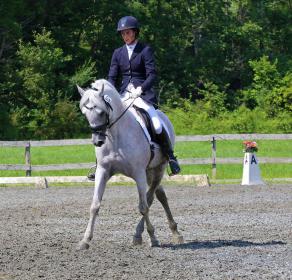
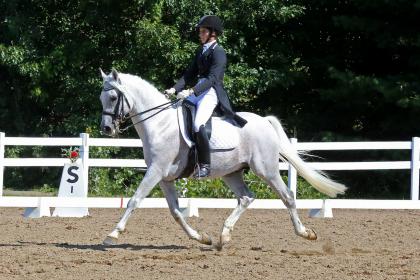
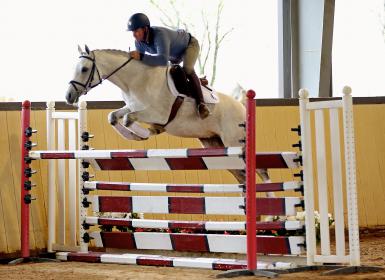
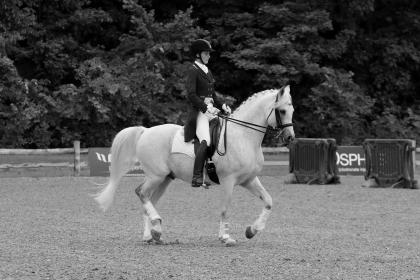
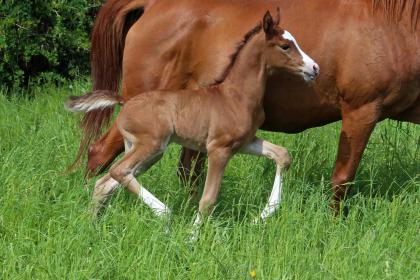
There is a farm in my area that do those crosses lovely smaller horses most are youngster just started under saddle I do not always truely love the conformation but they seem to be nice enough citizen and are started really well by an experienced and carefull horse women. we shall see how they turn out.
I also have a 2nd generation…he is by a Hanoverian stallion out of a arab/dutch mare. He represented the USA at the World Breeding Championships for Young Dressage Horses as a 6 year old, won the US Markel Championship as a 6 year old, Reserve Young Rider Champion, numerous CDI wins in the small tour. He didn’t piaffe well enough to do International GP. He took after his dad with size and conformation but does have a more refined face…he is now semi-retired and sound at age 19…
I bred my own Hanoverian/Arabian cross.  He’s by Tristtan (who showed up to GP) out of a huge, old school Hanoverian mare (Adios III). He’s around 16.2 hands. I love the cross - mostly for the arabian personality / brain with the warmblood gaits and more substance. I started him myself and have done all the riding/training so far with help from the ground.
He’s by Tristtan (who showed up to GP) out of a huge, old school Hanoverian mare (Adios III). He’s around 16.2 hands. I love the cross - mostly for the arabian personality / brain with the warmblood gaits and more substance. I started him myself and have done all the riding/training so far with help from the ground.
We haven’t shown in around a year due to some nagging injuries that we’ve finally cleared up, but he normally gets a 7 or 8 on gaits if I can get him relaxed over his back. He’s not a horse for everyone due to his smarts and athletic ability but I really enjoy him. I showed him in hand at USDF shows from the time he was 6 weeks old up until he aged out. We even went to Dressage at Devon twice and managed to bring home a ribbon. I’m not very interested in the arabian breed shows but it is nice to have the possibility to go if I want.
I’m pleased that Dawn JL chimed in about Obie and also glad that you mentioned that he is also approved for Shagya breeding. I am a member of NASS (North American Shagya Arabian Society) and Obie was approved with flying colors -
I’ve been wondering how he would cross with Shagya mares and would love to see pictures of his Shagya offspring (maybe in the next NASS Newsletter?) Shagyas embody a number of the qualities sought by those crossing Arabians with warmbloods - the bigger frame, added bone - wonderful temperaments. . .
I had three Shagyas - I lost my 24 year old gelding last winter, so now have two Shagyas- and one Arabian/WB cross mare which I am thoroughly enjoying - she is by Rosenthal out of a Polish/Gainey bred mare and has a very nice hind end and seems to have no problems “sitting”. She is also extremely bright and it’s not always easy staying one step ahead of her
Those of us who love Arabs find them irresistible with their bright minds, sparkling personalities, eagerness to please, lovely gaits. No horse or breed is perfect, of course but Arabs, Shagyas and Arab crosses come in a very nice package in my possibly ridiculous opinion.
